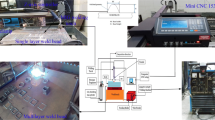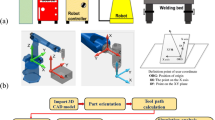Abstract
High-carbon steel wire ropes are used for various high-load-bearing applications. They achieve tensile strength of the order of 2 GPa owing to a combination of fine pearlitic microstructure and work hardening during the drawing process. Despite these high strength levels, they can fail during service due to either manufacturing defects or service abuse. In this study, failure analysis of main hoist steel wire rope used in a basic oxygen furnace (BOF) was carried out. Several locations of the wire rope showed unprecedented microstructural degradation. The presence of surface martensite with transverse cracks was observed in severely abraded wires. Some locations of the rope revealed fusion of adjacent wires with increased interlamellar spacing of pearlite and formation of divorced pearlite in heat-affected and fusion zones, respectively. A significant variation in hardness across the wire rope was noted due to these in-service microstructural changes. Such macroscopic and microstructural deterioration has not been reported in open literature. Detailed failure analysis of the wire rope along with a novel theory explaining the mechanisms of such microstructural degradation is presented herein. This study confirms that the wire rope suffered premature damage due to improper lubrication during service that led to direct metal-to-metal contact, associated friction, abrasion, and fusion of wires. Excessive friction and abrasion of wires subsequently led to fatigue of some of the wires, as manifested by square or crown breaks and striation marks.
Graphical Abstract












Similar content being viewed by others
References
M. Giglio et al., Life prediction of a wire rope subjected to axial and bending loads. Eng. Fail. Anal. 12, 549–568 (2005)
C.R. Chaplin et al., Interactive Fatigue in Wire Rope Applications (The University of Reading, Reading, 2008)
IS 7904, High Carbon Steel Wire Rods (Bureau of Indian Standards, New Delhi, 1995)
D.A. Porter, K.E. Easterling, Phase Transformations in Metals and Alloys, 2nd edn. (Nelson Thornes Ltd, Cheltenham, 1992)
T.V. Rajan et al., Heat Treatment: Principles and Techniques (PHI Learning Private Limited, New Delhi, 2011)
R.P. Singh et al., Studies on failure behaviour of wire rope used in underground coal mines. Eng. Fail. Anal. 70, 290–304 (2016)
K. Sipos et al., Surface martensite white layer produced by adhesive sliding wear friction in AISI-1065 steel. Revista Latinoamericana de Metalurgia y Materiales 28(1), 46–50 (2008)
S. Kou, Welding Metallurgy (Wiley, Second Edition, Hoboken, 2003)
A. Hultgren et al., Isothermal transformation of austenite. Trans. Am. Soc. Met. 39, 915–1005 (1947)
O.P. Modi et al., Effect of interlamellar spacing on mechanical properties of 0.65% carbon steel. Mater. Charact. 46, 347–352 (2001)
T. Oyama et al., Application of the divorced eutectoid transformation to the development of fine-grained, spheroidized structures in ultrahigh carbon steels. Scr. Metall. 18, 799–804 (1984)
H.K.D.H. Bhadeshia et al., Steels: Microstructures and Properties, 4th edn. (Elsevier, Amsterdam, 2017)
A.S. Pandit, H.K.D.H. Bhadeshia, Divorced pearlite in steels. Proc. R. Soc. A 468, 2767–2778 (2012)
Acknowledgements
The authors are grateful to Tata Steel Limited, Jamshedpur for financial support to carry out this work. The authors acknowledge the efforts of Mr. Dheeraj Lal and Mr. Vikram Sharma in metallography and fractography, respectively.
Author information
Authors and Affiliations
Corresponding author
Rights and permissions
About this article
Cite this article
Kishore, K., Mukhopadhyay, G. Novel Degradation Mechanism of a Structural Wire Rope During Its Life Cycle. Metallogr. Microstruct. Anal. 8, 189–200 (2019). https://doi.org/10.1007/s13632-018-0511-9
Received:
Revised:
Accepted:
Published:
Issue Date:
DOI: https://doi.org/10.1007/s13632-018-0511-9




